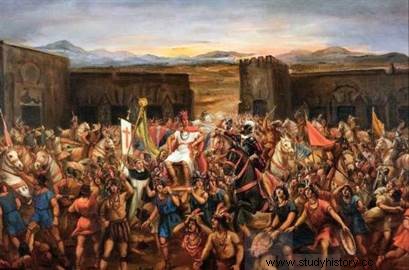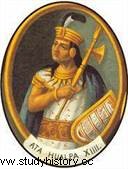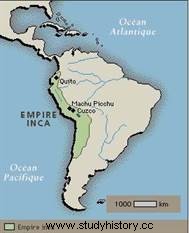 On November 16, 1532, the Inca Emperor Atahualpa was captured in the middle of his retinue by a small group of Spaniards led by Francisco Pizarro . This daring attack, coupled with a terrible massacre, would sound the death knell of the Inca Empire and begin its conquest by the Spaniards. However, there was no indication that a handful of Spanish adventurers would, in a single day, deliver a fatal blow to the largest empire in pre-Columbian America.
On November 16, 1532, the Inca Emperor Atahualpa was captured in the middle of his retinue by a small group of Spaniards led by Francisco Pizarro . This daring attack, coupled with a terrible massacre, would sound the death knell of the Inca Empire and begin its conquest by the Spaniards. However, there was no indication that a handful of Spanish adventurers would, in a single day, deliver a fatal blow to the largest empire in pre-Columbian America.
Francisco Pizarro in search of Peru
Castilian emigrated to the Americas in 1502, Francisco Pizarro settled in Panama in 1513. It was there that he heard for the first time, following the voyage of exploration of his compatriot Pascual de Andagoya, of a fabulous country that would abound in gold:Peru . Encouraged by the incredible success of Hernan Cortès , who with a handful of conquistadors manages to submit the Aztec empire, he decides to join forces with two other men, the priest Hernando de Luque, and the soldier Diego de Almagro , to conquer this legendary Peru.
 Their first expedition, in 1524-25, was a fiasco:their ship was damaged, suffered deprivation and the hostility of the tribes that inhabit what is now Ecuador , the Spaniards give up. But in 1526-28, a second expedition bore fruit:Pizarro and his companions established contact with a population recently submitted by the Incas and above all, they find gold, silver and precious stones:Peru does indeed exist. Anxious to ensure the best part of the conquest to come, he returned to Spain and managed to get himself appointed, in advance, governor of "New Castile" by Charles V . He returned to Panama in 1530, taking several of his brothers with him.
Their first expedition, in 1524-25, was a fiasco:their ship was damaged, suffered deprivation and the hostility of the tribes that inhabit what is now Ecuador , the Spaniards give up. But in 1526-28, a second expedition bore fruit:Pizarro and his companions established contact with a population recently submitted by the Incas and above all, they find gold, silver and precious stones:Peru does indeed exist. Anxious to ensure the best part of the conquest to come, he returned to Spain and managed to get himself appointed, in advance, governor of "New Castile" by Charles V . He returned to Panama in 1530, taking several of his brothers with him.
Francisco Pizarro's third expedition finally set sail in December 1530. The following spring, it reached the island of Puna , whose inhabitants deliver to the Incas, on the continent, a merciless war. Initially the cohabitation proceeds smoothly, but a misunderstanding caused by the translators of Pizarro triggers an armed conflict in April 1531:although being less than 200, the Spaniards inflict a crushing defeat on the natives, thanks to the combination pikes /arquebuses infantry, and their cavalry . Impressed by this success, which gave the conquistadores an aura of almost supernatural invincibility, the Incas welcomed the Spaniards with deference, while Pizarro and his family, without meeting any resistance, went inland.
Meeting Atahualpa
At the same time, the Inca emperor Atahualpa is in Cajamarca with an army of 80,000 men, where he has just learned of the defeat and capture of his half-brother Huascar , his rival in a civil war for the imperial succession that has been going on since 1527. He is informed almost simultaneously of the arrival of these Spaniards with exotic arms and attire, from whom his people respectfully stand apart. But the son of the sun is not fooled:his spies soon teach him that the newcomers are not of divine essence. The emperor saw in it a unique opportunity to strengthen his power, still tenuous after the civil war:he would capture the Spaniards to incorporate them into his own army and benefit from their military know-how - or have them put to death they refuse.
 With this in mind, and believing that we have nothing to fear from the handful of conquistadors given the presence of his armed, he sends a messenger to Pizarro inviting him to meet him in Cajamarca. After an exhausting march, the 168 Spaniards, taking with them 62 horses, 12 arquebuses and 4 cannons, arrived in the city, which its inhabitants had almost deserted during the civil war, on November 15, 1532. They were immediately confronted with a thorny dilemma. Indeed, attacking the Inca army head-on, which is camped on the heights overlooking the city, would be suicidal. Beating a retreat could not be envisaged:the many fortresses that the Spaniards crossed on the way would have quickly blocked their way, in these mountainous regions. Finally, remaining passive in contact with the Incas would only contribute to dissipating the aura of mystery that the conquistadores still imagined to have.
With this in mind, and believing that we have nothing to fear from the handful of conquistadors given the presence of his armed, he sends a messenger to Pizarro inviting him to meet him in Cajamarca. After an exhausting march, the 168 Spaniards, taking with them 62 horses, 12 arquebuses and 4 cannons, arrived in the city, which its inhabitants had almost deserted during the civil war, on November 15, 1532. They were immediately confronted with a thorny dilemma. Indeed, attacking the Inca army head-on, which is camped on the heights overlooking the city, would be suicidal. Beating a retreat could not be envisaged:the many fortresses that the Spaniards crossed on the way would have quickly blocked their way, in these mountainous regions. Finally, remaining passive in contact with the Incas would only contribute to dissipating the aura of mystery that the conquistadores still imagined to have.
Pizarro, who understood well the divine status of the sovereign and the nature centralized power of his empire, therefore decides to act, with astounding nerve:he will capture Atahualpa in the midst of his own soldiers, setting a trap for him. The Spanish leader therefore invites the emperor to come and meet him the next day inside Cajamarca. Sure of his strength, Atahualpa accepts. The cramped conditions forced him to bring with him only the few thousand soldiers and courtiers who constituted his immediate suite. As a sign of goodwill, he further clarifies that his people will not bring their weapons.
The "battle" of Cajamarca
On November 16, 1532 , while Atahualpa and his suite enter the city, the Spaniards remain hidden in the buildings that surround the central square. Only the Dominican monk Vincente de Valverde advances to meet the sovereign, a Bible in hand. The rest is not known with precision, no other Spaniard having heard the conversation between the two men:the later accounts of the chroniclers (in particular those of Pedro Cieza de Léon and Garcilaso de la Vega) contradict each other on its content. According to some, the monk would have first invited Atahualpa to descend from his palanquin to come and feast inside one of the houses, which the Inca would have refused. For others, he would have simply summoned him to accept Jesus Christ as god and Charles V as suzerain.
 The outcome of the meeting also differs depending on the sources. There seems to have been an altercation between Atahualpa and Valverde, about the bible that the latter handed to the sovereign. Atahualpa, not knowing what to do with the book – an object totally unknown to his people – would then have impatiently struck the monk who wanted to help him open it; after which the emperor, unimpressed by the work, would have simply thrown it to the ground. It is then unclear whether Valverde would have taken the opportunity to urge his companions to attack, or if he would simply have returned to report the incident to Pizarro, who would then have ordered the attack.
The outcome of the meeting also differs depending on the sources. There seems to have been an altercation between Atahualpa and Valverde, about the bible that the latter handed to the sovereign. Atahualpa, not knowing what to do with the book – an object totally unknown to his people – would then have impatiently struck the monk who wanted to help him open it; after which the emperor, unimpressed by the work, would have simply thrown it to the ground. It is then unclear whether Valverde would have taken the opportunity to urge his companions to attack, or if he would simply have returned to report the incident to Pizarro, who would then have ordered the attack.
One thing is certain:violence, then, is unleashed. The Spaniards rush to attack, with their steel swords, their metal armor and their crossbows. The Incas, who are for the luckiest of them protected only by leather armor, and without weapons, discover moreover for the first time arquebuses, cannons and horses, which mow down, overthrow and trample their serried ranks with a terrifying efficiency. The "battle" turns into a bloodbath.
The capture of Atahualpa
However, the Spaniards failed to seize Atahualpa, still out of reach on his palanquin. They then begin to methodically cut off the arms of the carriers but, as some of them will later report to Pedro Cieza de Léon, they see with amazement the wounded get up to carry the litter of the sovereign with their other arm.
Finally, the emperor's last defenders are massacred and Atahualpa captured, while the Spanish horsemen pursue the fugitives through the streets of the city, probably killing several hundred or even thousands. On the Spanish side, there are probably only a few wounded, including Pizarro himself, slightly hit in the hand parrying the blow of a blade that one of his men, in the heat of the action, intended for Atahualpa.
The conquest of the Inca Empire by Pizarro
 Alive, the emperor-god of the Incas was indeed the most powerful bargaining chip that Francisco Pizarro could dream. The conquistador had decapitated the empire at the same time. A veritable puppet in the hands of the Spaniards, Atahualpa had to order his armies to withdraw under threat. He offered to pay a ransom for his own freedom:the equivalent in gold of the volume of the room where he was imprisoned, and a double quantity of silver. Pizarro accepted the deal, though he had no intention of keeping his word. Once the ransom was paid, when it became clear that Atahualpa's generals no longer obeyed him, Pizarro had him put to death. Having agreed to be baptized so as not to die burned alive (in the Inca religion, the soul of a dead man cannot reach the afterlife if his body is burned), Atahualpa was garrote on August 29, 1533.
Alive, the emperor-god of the Incas was indeed the most powerful bargaining chip that Francisco Pizarro could dream. The conquistador had decapitated the empire at the same time. A veritable puppet in the hands of the Spaniards, Atahualpa had to order his armies to withdraw under threat. He offered to pay a ransom for his own freedom:the equivalent in gold of the volume of the room where he was imprisoned, and a double quantity of silver. Pizarro accepted the deal, though he had no intention of keeping his word. Once the ransom was paid, when it became clear that Atahualpa's generals no longer obeyed him, Pizarro had him put to death. Having agreed to be baptized so as not to die burned alive (in the Inca religion, the soul of a dead man cannot reach the afterlife if his body is burned), Atahualpa was garrote on August 29, 1533.
Pizarro, for his part, continued the conquest of Peru, entering Cuzco , the Inca capital, on December 20, 1533. The story, however, was not over:the 17-year-old puppet he had placed on the throne, Manco Capac II , would soon join the renegade generals who were continuing the struggle against the Spaniards in the mountains. Moreover, Pizarro was to stir up the jealousies of his comrades in arms against him, and internal struggles were soon to tear the conquistadors apart. Pizarro succeeded in having his most dangerous rival, his former associate Diego de Almagro, executed in 1538; but he was going to perish in his turn, murdered by the partisans of the son of Almagro, on June 26, 1541. The latter will finally be defeated and put to death the following year. It was not until 1572 that the last remnant of the Inca Empire was defeated with the execution of the last emperor, Tupac Amaru .
Bibliography
- Francisco Pizzaro:The Conquistador of the Extreme, by Bernard Lavallé. Payot, 2004.
- Atahualpa, the last Inca emperor, by Alexandre Gomez-Urbina. MA Editions, 2019.
- From William H. Prescott, History of the Conquest of Peru, Volume 2:The Fall of the Inca Empire. Pygmalion, 1997.
